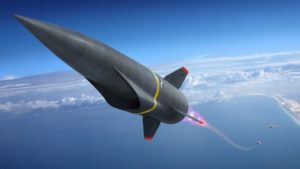The Navy’s Strategic Systems Program successfully conducted a test of the first stage Solid Rocket Motor (SRM) on May 27 for the Defense Department’s hypersonic weapon effort.
The test occurred in Promontory, Utah and specifically is part of the development work for the Navy’s Conventional Prompt Strike (CPS) and the Army Long Range Hypersonic Weapon (LRHW) offensive hypersonic weapons.
The Navy noted this was the initial live fire test of the first stage SRM and called it a “vital step in the development of a Navy-designed common hypersonic missile that will be fielded by both the Navy and Army.”

The Lockheed Martin [LMT] and Northrop Grumman [NOC] team participating in the weapon development specified this was a live fire ground test of the first stage solid rocket motor. The motor fired for the full trial duration “and met performance parameters and objectives within anticipated ranges,” the companies added.
The Defense Department is developing a hypersonic weapon to be shared by the services in the CPS/LRHW mission, called the Common Hypersonic Glide Body (C-HGB). To this end, the Navy is managing development of the C-HGB while the Army will oversee production of the final product.
The Navy plans to then buy a common missile stock rocket booster to lift the glide body to the edge of space that, when combined with the C-HGB, makes up an all-upround that will be used by the Army and Navy from different launching platforms. The Air Force plans to use the same C-HGB but with a different launching system separate from this rocket booster.
The Navy reiterated the tested first stage SRM will be part of that rocket booster to be combined with the C-HGB. The Pentagon aims to field a hypersonic weapon in the early-to-mid 2020s.
“This successful SRM test represents a critical milestone leading up to the next Navy and Army joint flight test, which will take place in the first quarter of Fiscal Year 2022, and ultimately the fielding of the CPS and LRHW weapon systems,” the Navy said Thursday.
Last year, the Pentagon conducted a successful flight test of the C-HGB (Defense Daily, March 20, 2020).
“The services are working closely with government national laboratories and industry to continue development and production of the CHGB,” the Navy said in a statement.
“Information gathered from this and future tests will further inform the services’ offensive hypersonic technology development,” the Navy added.
“We’re pleased to celebrate this important event with the U.S. Navy, Army and Northrop Grumman. This outcome today is due to our shared effort and determination to see this test on the Conventional Prompt Strike program succeed,” Steve Layne, program director of Conventional Strike Programs at Lockheed Martin, said in a statement..
“This live fire event is a major milestone on the path to providing hypersonic strike capability to the U.S. Navy and U.S. Army warfighters,” he added.
Northrop Grumman developed the motor while Lockheed Martin serves as the prime weapon systems integrator to provide boost capability to the hypersonic missile for the Army and Navy.
“Northrop Grumman is proud to leverage our expertise in flight-proven solid rocket propulsion to support the nation’s efforts to develop an advanced end-to-end missile system capable of deterring emerging and future threats,” Charlie Precourt, vice president of Propulsion Systems at Northrop Grumman, said in a statement.
Last August, the Army’s Director of Hypersonics, Directed Energy, Space, and Rapid Acquisition, Lt. Gen. L. Neil Thurgood, outlined the schedule of C-HGB tests following the first one in March 2020. The following flight test was scheduled for mid-2021 to be followed “very quickly” by two more shots also this year (Defense Daily, Aug. 6, 2020).
In 2019, Lockheed Martin won an $846 million contract modification for the design, development, build and integration of equipment for the Navy Intermediate Range CPS weapon system (Defense Daily, Feb. 27, 2019).
Later that year, the company won an additional $406 million modification to design and build large diameter rocket motors and missile body components to support Army flight tests for the Intermediate Range CPS Weapon program (Defense Daily, Aug. 6, 2019).
Then, last March the Navy awarded Lockheed Martin an additional $1.5 billion modification for the design, development, build and integration of equipment for missile flight test demonstrations and fielding. This raised the total program value to the company to $2.8 billion (Defense Daily, March 12).